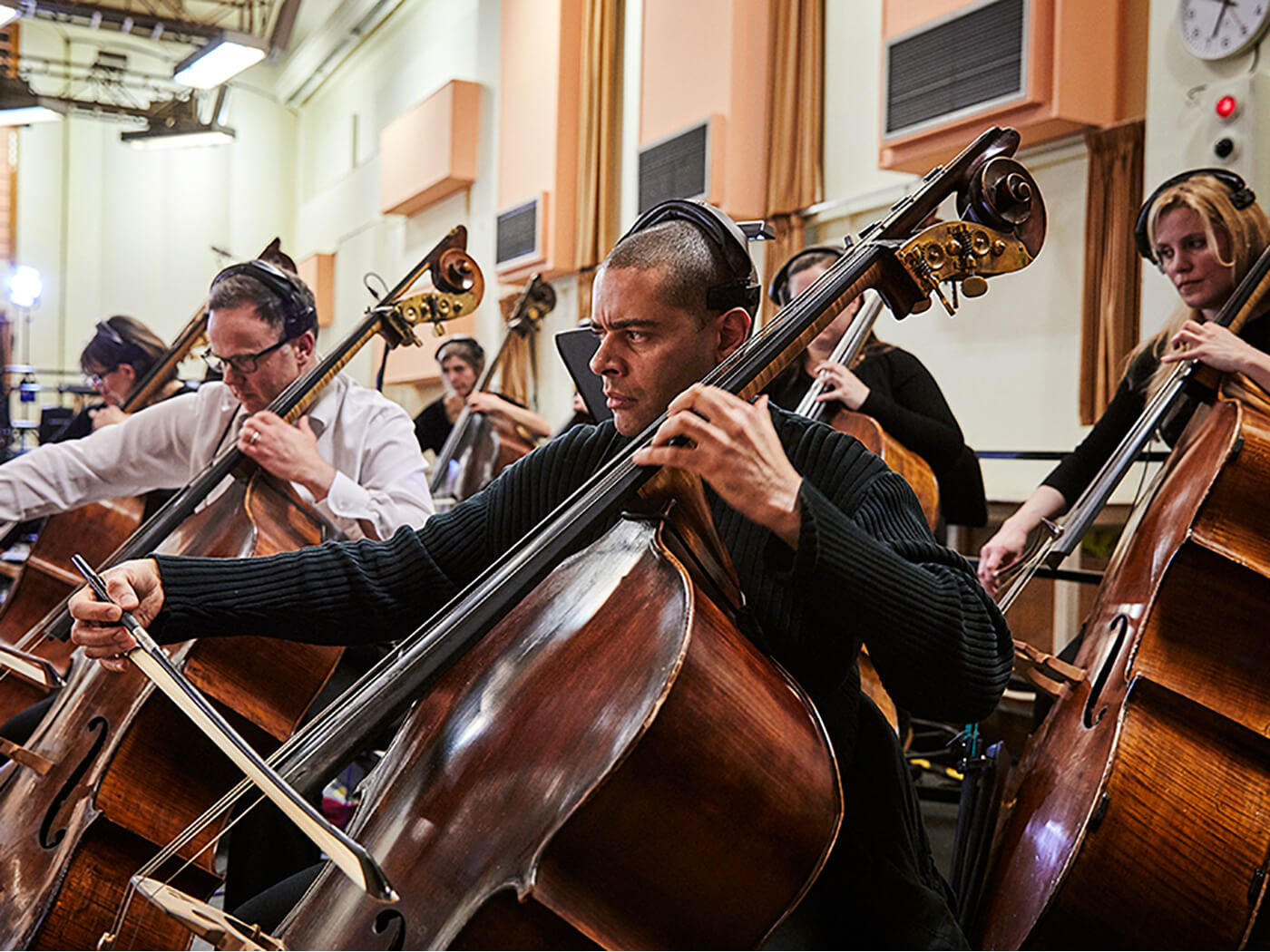Home>Instruments>Bass>What Does A Double Bass Look Like


Bass
What Does A Double Bass Look Like
Modified: January 22, 2024
Discover what a double bass looks like and learn about its unique features. Explore the anatomy and design of this classical instrument.
(Many of the links in this article redirect to a specific reviewed product. Your purchase of these products through affiliate links helps to generate commission for AudioLover.com, at no extra cost. Learn more)
Table of Contents
Introduction
The double bass is a magnificent instrument that brings depth, richness, and power to any musical ensemble. It holds a prominent place in the orchestra, providing the foundation for the harmony and rhythm of the music. Its deep, resonant tones fill concert halls and captivate audiences with their enchanting vibrations.
Also known as the contrabass or upright bass, the double bass is the largest and lowest-pitched member of the orchestral string family. Its impressive size and distinct appearance make it a remarkable instrument to behold. But what exactly does a double bass look like? Let’s explore its anatomy and discover the fascinating features that make it so unique.
The instrument consists of several essential components, each contributing to its overall functionality and sound production. Understanding these parts will provide valuable insight into the instrument’s construction and how it achieves its extraordinary sonic capabilities.
In this article, we will delve into the various elements that compose a double bass, including the body, neck and fingerboard, scroll, strings and tuning pegs, bridge, tailpiece, soundpost, and bow. By examining these components in detail, we can gain a comprehensive understanding of its physical structure and the role each component plays in producing its iconic sound.
Whether you are a musician, a music enthusiast, or simply curious about musical instruments, this article aims to shed light on the remarkable double bass and its intricate design. So, let’s dive in and explore the fascinating world of the double bass’s anatomy!
Anatomy of a Double Bass
The double bass is a truly remarkable instrument, both in terms of its size and complexity. Its anatomy consists of various components that work together to create its unique sound. Understanding the different parts of a double bass is crucial for musicians and enthusiasts alike, as it provides insight into how the instrument produces its deep and resonant tones.
Let’s start our exploration of the double bass anatomy with the body. The body of the instrument is the large, hollowed-out structure that forms the sound chamber. Typically made from spruce or maple, the body is responsible for amplifying and projecting the vibrations of the strings, creating the bass’s distinct sound.
Next, we have the neck and fingerboard. The neck is a long, slender piece that extends from the body and holds the fingerboard in place. The fingerboard, usually made from ebony, is a smooth and flat surface where the musician presses down on the strings to produce different pitches. It is through the precise placement of fingers on the fingerboard that the musician can create a wide range of melodic and harmonic possibilities.
The scroll, located at the topmost end of the neck, adds a touch of elegance to the double bass. Its intricate design is often handmade and serves primarily as a decorative element. The scroll also provides a convenient grip for the musician when adjusting the instrument’s position.
The strings and tuning pegs are essential features of any double bass. The traditional double bass has four strings, typically tuned to E1, A1, D2, and G2. These strings are typically made of steel or a synthetic core wrapped with various metals. To adjust the tension and pitch of each string, the musician uses the tuning pegs located at the top of the instrument’s headstock. By turning the pegs clockwise or counterclockwise, the musician tightens or loosens the strings to achieve the desired pitch.
The bridge, a wooden piece placed between the belly and the fingerboard, supports the strings and transmits their vibrations to the body of the instrument. It plays a crucial role in maintaining string height and distributing the sound evenly across the instrument’s body.
Connected to the tailpiece, another important component, the strings are securely anchored. The tailpiece is typically made of wood, metal, or carbon fiber and holds the strings in place while allowing them to vibrate freely.
The soundpost, a small wooden dowel inside the instrument, helps maintain the structural integrity of the double bass and enhances its tone. Placed between the back and front plates, the soundpost transfers vibrations from the strings to the body, contributing to the instrument’s overall resonance.
Lastly, we have the bow, a vital part of the double bass playing experience. The bow consists of a wooden or carbon fiber stick with horsehair stretched between the ends. By drawing the bow across the strings, musicians can produce a wide range of articulations and dynamic nuances.
Now that we have explored the primary components of a double bass’s anatomy, we have a better understanding of how these elements work together to create the instrument’s distinctive sound. The next time you admire a double bass in an orchestra or music store, you’ll have a deeper appreciation for the craftsmanship and engineering behind this magnificent instrument.
The Body
The body of a double bass is the large, hollowed-out structure that forms the sound chamber and gives the instrument its distinctive shape. It is one of the most essential components and plays a crucial role in the instrument’s sound production.
Typically made from spruce or maple, the body of the double bass undergoes a meticulous construction process. The top, also known as the belly or soundboard, is made from a carefully selected piece of spruce. This thin piece of wood is carved and shaped to create a slight arch, allowing for better resonance and projection of sound.
The back of the double bass, usually made from maple, contributes to the instrument’s tonal character. The back is also arched and features a unique grain pattern that adds aesthetic appeal to the instrument. The back and the top are joined together at the edges, forming the “ribs” or sides of the instrument.
The body of the double bass is notably large, ranging from around 43 to 47 inches in height. This size is necessary to produce the low frequencies and deep resonance that the instrument is known for. The larger the body, the more volume and richness the instrument can generate.
Within the hollow cavity of the body, there are sound post and bass bar. The sound post is a small wooden dowel placed inside the instrument between the top and back plates. It is positioned underneath the treble side of the bridge and helps transmit vibrations between the top and back plates, enhancing the instrument’s resonance and tonal response.
The bass bar is a long and thin wooden strip that runs underneath the bass side of the top plate. It acts as a support for the top plate, helping distribute the vibrations of the strings evenly across the soundboard. This distribution of vibrations is crucial in producing a balanced and full-bodied sound.
The body of the double bass not only contributes to the sound but also affects the instrument’s visual appeal. Many luthiers take pride in the craftsmanship of the body, creating beautifully carved and finely polished surfaces. The wood grain patterns, varnish, and overall finish of the body add to the instrument’s aesthetic charm.
When playing the double bass, the musician stands or sits behind the instrument and bows or plucks the strings. The sound produced by the strings is projected from the body, filling the room with rich, deep bass tones. The size and resonance of the body allow for the instrument’s powerful projection, making it ideal for orchestras and ensembles where it provides the foundation for the musical arrangement.
In summary, the body of a double bass is a marvel of craftsmanship and design. It is the foundation upon which the instrument’s sound is built, providing the resonance necessary for the deep and powerful bass tones. The construction materials, shape, arching, and internal components such as the sound post and bass bar all contribute to the instrument’s unique sound and striking visual appearance.
The Neck and Fingerboard
The neck and fingerboard are crucial components of a double bass, playing a significant role in the instrument’s playability and sound production. The neck is a long, slender piece of wood that extends from the body, supporting the fingerboard.
The neck is usually crafted from maple or another durable hardwood. It is carefully shaped to provide stability and strength while allowing for easy hand movement along the fingerboard. The length of the neck can vary, but it typically measures around 43 to 46 inches in length.
Located on top of the neck is the fingerboard, which is attached and secured to the neck’s surface. The fingerboard is generally made from ebony, a dense and durable wood known for its smooth texture and resistance to wear. Its dark color contrasts beautifully with the lighter wood of the neck.
The fingerboard is a vital interface between the musician and the instrument. Its flat, smooth surface provides a consistent and even playing area for the musician’s fingers. Along the length of the fingerboard, small ridges or frets are often added to serve as a guide for proper finger placement and intonation. However, unlike frets found on guitars or other stringed instruments, double bass fingerboards are typically fretless, allowing for greater expressive possibilities and flexibility in pitch.
When playing the double bass, the musician presses down on the strings against the fingerboard to change the pitch of the notes produced. By adjusting the position of their fingers along the fingerboard, the musician can create a wide range of melodic and harmonic possibilities. This technique, known as fingering, requires precision and practice to achieve accurate intonation and produce the desired tone.
Strings on the double bass can be quite thick, and the pressure exerted on the fingerboard by the musician’s fingers can be significant. To reduce friction and ensure smooth movement, a thin layer of graphite or other lubricants may be applied to the surface of the fingerboard.
The shape and length of the neck, as well as the width and curvature of the fingerboard, can vary between different double basses. These factors can greatly affect the playability and comfort for the musician. Some necks may have a slight curve or taper towards the scroll, allowing for easier hand positioning and reach. Others may have a more substantial and more robust neck, providing a solid foundation for playing with strength and control.
In summary, the neck and fingerboard of a double bass are vital components that enable the musician to produce accurate pitches and achieve nuanced playing techniques. The neck provides stability and support, while the fingerboard offers a smooth and responsive surface for the musician’s fingers. Together, they contribute to the instrument’s playability and facilitate the creation of rich, resonant music.
The Scroll
The scroll is a distinctive and ornamental feature found at the top end of the double bass neck. It is a beautifully carved wooden adornment that adds elegance and character to the instrument. While primarily a decorative element, the scroll also serves a practical purpose as a convenient grip for musicians when adjusting the instrument’s position.
The scroll is often handcrafted by skilled luthiers, showcasing their artistry and craftsmanship. It is typically made from the same type of wood as the rest of the instrument, such as maple or another hardwood. The scroll’s design varies, but it commonly features intricate swirls, volutes, and can be personalized with ornate carvings or patterns.
One practical function of the scroll is to serve as a handle for the musician when positioning the instrument. By grasping the scroll, the musician can lift and maneuver the double bass more easily, particularly when adjusting the instrument’s position or moving it from one location to another.
Another notable characteristic of the scroll is its scroll box, also known as the pegbox or headstock. This is the part of the scroll that accommodates the tuning pegs. The scroll box is hollowed out and contains four or more holes, each fitted with a tuning peg.
Tuning pegs are crucial components that allow the musician to adjust the tension and pitch of the double bass strings. The pegs are inserted into the holes in the scroll box and turned clockwise or counterclockwise to tighten or loosen the strings. By carefully turning the tuning pegs, the musician can achieve precise control over the instrument’s intonation, ensuring that each string is in tune with the desired pitch.
Beyond its functional purpose, the scroll serves as a visual representation of the double bass’s craftsmanship and beauty. While its design may vary, the scroll contributes to the instrument’s overall aesthetic appeal, creating a sense of refinement and elegance.
The scroll is a fundamental part of the double bass’s identity and gives the instrument a unique and recognizable look. Its presence adds a touch of sophistication to the instrument, distinguishing it from other members of the string family.
So, the next time you see a double bass, take a moment to appreciate the intricate scroll at the top of the neck. Its exquisite design and practical function symbolize the skillful artistry and timeless beauty that make the double bass a truly remarkable instrument.
The Strings and Tuning Pegs
Strings and tuning pegs are critical components of a double bass, playing a significant role in determining the instrument’s sound and pitch. The strings, typically made of steel or synthetic core wrapped with various metals, produce the vibrations that create the instrument’s deep and resonant tones.
The double bass traditionally has four strings, tuned to E1, A1, D2, and G2. The thickest string, the E string, is the lowest in pitch, while the G string is the highest. The strings are attached at the tailpiece, located at the bottom end of the instrument, and are stretched over the fingerboard and bridge, transmitting their vibrations to the body of the double bass.
The choice of strings can greatly impact the instrument’s tone and playability. Different types of strings offer varying characteristics, such as warmth, brightness, projection, and response. Musicians often experiment with different string brands and combinations to achieve the desired sound and feel.
Tuning pegs are crucial for adjusting the tension and pitch of each string. Typically made from hardwood like ebony, the tuning pegs are inserted into holes on the scroll box, situated at the top end of the instrument’s neck. By turning the pegs clockwise or counterclockwise, the musician tightens or loosens the strings, bringing them to the desired pitch.
Keeping the instrument in tune requires careful adjustment of each string’s tension using the tuning pegs. Additionally, fine tuners, small screws or levers, may be attached to the tailpiece to provide more precise tuning adjustments. Fine tuners make slight tweaks to the string tension without needing to turn the tuning pegs, offering convenience during performances or rehearsals where quick adjustments are necessary.
Tuning a double bass requires precision and practice. Musicians tune their instrument by comparing the pitch of the strings to a reference, such as a tuning fork, electronic tuner, or another instrument. Once the strings are correctly tuned, the musician can produce harmonious and in-tune notes with ease.
Regular maintenance and care are crucial for prolonging the lifespan of the strings and ensuring optimal performance. Strings can wear out over time due to factors like tension, humidity, and frequency of play. Regularly inspecting the strings for wear, cleaning them, and replacing them when necessary is vital for maintaining the instrument’s sound quality.
Strings and tuning pegs are integral components of the double bass, working together to produce the desired pitch and tone. The ability to adjust the tension and pitch of each string provides versatility and control for the musician, allowing them to express themselves and create a wide range of musical sounds on this magnificent instrument.
The Bridge
The bridge is a crucial component of a double bass, serving as a vital link between the strings and the body of the instrument. Positioned between the belly and the fingerboard, the bridge plays a significant role in transmitting the vibrations of the strings to the instrument’s soundboard, also known as the resonating surface.
A well-crafted double bass bridge is typically carved from a single piece of hard, dense wood, such as maple or another hardwood. It is carefully shaped to provide stability and support for the strings while allowing for optimal transmission of vibrations to the instrument’s body.
The bridge is designed to be slightly arched, ensuring even distribution of the string tension across the soundboard. This arch, also known as the belly curve, facilitates the production of a balanced and resonant sound. Moreover, the curvature of the bridge allows for vertical height adjustments of the strings, enabling musicians to achieve the desired string height and playability.
At the top of the bridge, there are notches, known as string notches or string slots. These notches hold the strings securely in place and ensure they are properly aligned over the fingerboard. The strings must sit in their respective slots to maintain correct spacing and avoid buzzing or rattling against the fingerboard during play.
The positioning and alignment of the bridge are critical for good intonation and optimal sound quality. Luthiers carefully place and adjust the bridge, considering factors such as string tension, string height, and the desired tonal characteristics of the instrument. Improper bridge placement or alignment can result in poor intonation, buzzing strings, or a loss of tone and resonance.
One unique aspect of a double bass bridge is the adjuster wheels or screws found on either side of the bridge. These wheels, also known as bridge adjusters or bridge height adjusters, allow for precise changes in string height without having to remove the bridge. By turning the adjuster wheels, a musician can fine-tune the action of the strings, ensuring comfortable playability and optimal sound projection.
Regular care and maintenance of the bridge are essential for preserving its functionality and longevity. Checking for any signs of warping, wear, or damage is crucial. Periodically lubricating the contact points between the bridge and the belly with a substance like graphite or pencil lead can help minimize friction and ensure optimal vibration transmission.
In summary, the bridge of a double bass acts as a crucial intermediary between the strings and the body of the instrument. Its sturdy construction, precise placement, and adjustability have a significant impact on the instrument’s playability, intonation, and sound projection. With proper care and attention, the bridge allows the double bass to produce its distinct, resonant tones, contributing to the instrument’s overall performance and musical expression.
The Tailpiece
The tailpiece is a fundamental component of a double bass that anchors the strings to the instrument’s body. It is located at the bottom end, opposite the bridge, and plays a crucial role in providing stability and supporting the tension of the strings.
The tailpiece can be made from a variety of materials, including wood, metal, or carbon fiber. Each material offers different characteristics in terms of durability, weight, and resonance. Traditional wooden tailpieces are often carved from hardwood like ebony, while modern tailpieces may incorporate lightweight and durable materials to enhance performance.
The primary function of the tailpiece is to hold the strings securely in place while allowing them to vibrate freely. It typically has holes or slots where the strings pass through before being attached to their corresponding tuning pegs at the scroll box. This configuration ensures proper alignment and tension for accurate intonation and sound production.
Some tailpieces may have additional features such as built-in fine tuners. These small adjustable screws or levers provide convenient fine-tuning capabilities for quick and precise changes in string tension. Fine tuners are especially useful during performances or rehearsals when small adjustments are required without the need for turning the tuning pegs.
The tailpiece also affects the instrument’s tone and resonance. Different materials and designs can impact the instrument’s overall sound projection and timbre. For example, a lighter tailpiece may enhance the instrument’s responsiveness and brightness, while a heavier tailpiece can contribute to a warmer and more resonant tone.
Maintaining the tailpiece is essential for optimal performance and longevity. Regular inspection for cracks, wear, or damage is vital, as a damaged tailpiece can jeopardize the stability and tension of the strings. Cleaning the tailpiece with a soft cloth and occasionally applying a small amount of lemon oil or other appropriate cleaning solutions can help keep it in good condition.
When changing strings, updating or upgrading the tailpiece can be considered. Different tailpiece materials and designs can potentially affect the instrument’s sound and playability. Experimenting with different tailpieces can allow musicians to personalize their instrument’s tone and responsiveness to suit their preferences and playing style.
In summary, the tailpiece is a critical component of a double bass that provides stability, holds the strings securely, and contributes to the instrument’s overall tone and resonance. Its design, material, and additional features such as fine tuners can impact playability and sound production. By properly maintaining and considering different tailpiece options, musicians can optimize the performance and sound characteristics of their double bass.
The Soundpost
The soundpost is a small, cylindrical wooden dowel positioned inside the double bass, serving as a critical component in producing the instrument’s resonant and balanced sound. It is situated between the front and back plates of the double bass, facilitating the transfer of vibrations from the strings to the body of the instrument.
The soundpost is typically made from spruce or another hardwood, carefully carved to fit precisely between the two plates of the double bass. Placed underneath the treble side of the bridge, it supports the tension of the strings and helps maintain the structural integrity of the instrument.
The primary function of the soundpost is to transmit vibrations from the strings to the body of the instrument. When the strings are played, they cause the bridge to vibrate. These vibrations are then transferred through the bridge to the soundpost, which transmits them further into the top and back plates of the double bass.
By connecting the front and back plates, the soundpost enhances the resonance and tonal response of the instrument. It helps distribute vibrations evenly across the instrument’s surface, ensuring a balanced and full-bodied sound. Additionally, it contributes to the stability and structural integrity of the instrument, preventing excessive deformation and maintaining its overall form.
The placement and positioning of the soundpost are crucial for optimal sound production. Luthiers carefully adjust and fit the soundpost to ensure proper alignment and contact between the plates. The precise location and angle of the soundpost can have a significant impact on the instrument’s tone, responsiveness, and projection.
While it may seem deceptively simple, adjusting the soundpost requires specialized expertise. Small alterations to its position can result in noticeable changes to the instrument’s sound. Luthiers with a deep knowledge of instrument construction and acoustics carefully manipulate the soundpost’s placement, ensuring the instrument achieves its optimal sonic characteristics.
Regular maintenance and inspection of the soundpost are vital for the instrument’s performance. Periodically, a luthier may need to adjust or replace the soundpost to maintain its optimal positioning and functioning. As the double bass experiences changes in temperature, humidity, and string tension, these factors can affect the soundpost’s fit and stability.
In summary, the soundpost of a double bass is a crucial component that enhances the instrument’s resonance, tonal response, and structural stability. Positioned between the front and back plates, it facilitates the transfer of vibrations from the strings to the body, contributing to the instrument’s unique voice and character. With proper placement and maintenance, the soundpost ensures the double bass produces a rich, resonant sound that captivates audiences and enriches musical performances.
The Bow
The bow is a vital tool for playing the double bass, allowing musicians to bring out the instrument’s full range of expressive capabilities. It is a long, slender wooden or carbon fiber stick with horsehair stretched between its ends, creating a graceful and resilient arc.
The construction of the bow has evolved over centuries, incorporating different materials and innovations. Traditional bows were made from pernambuco wood, which offers excellent strength, flexibility, and responsiveness. However, due to conservation concerns and limited availability, modern bows often utilize carbon fiber or fiberglass as alternative materials. These modern materials offer durability, stability, and consistent performance.
One end of the bow features a convex-shaped “frog” made from a hard material like ebony or other dense woods. The frog contains a mechanism called the “adjuster” or “screw,” allowing musicians to modify the tension of the bow hair. By tightening or loosening the screw, musicians can control the amount of bow hair in contact with the strings, influencing factors such as volume, tone, and sustain.
Attached to the frog is the bow hair, which is usually made from horsehair. The hair is carefully stretched and secured to the bow, running along the length of the stick. When the musician draws the bow across the strings, the friction between the bow hair and the strings creates vibrations that produce sound.
The weight, balance, and curve of the bow play a crucial role in shaping the double bass’s sound. Different bows offer varying characteristics, such as responsiveness, dynamics, and tonal range. Musicians often experiment with different bows to find the one that complements their playing style and allows them to achieve their desired sound.
Playing the double bass with the bow requires skill and technique. The musician holds the bow with a relaxed grip, positioning their hand between the frog and the middle of the stick. By applying pressure and controlling the speed and angle of the bow, musicians can create a range of articulations, from smooth and legato passages to spiccato and staccato strokes.
Bow technique is essential for producing a wide array of musical effects and dynamics. Musicians learn how to achieve varying degrees of pressure, speed, and bow placement for expressive phrasing, accents, and nuanced playing. Proper bowing technique is also crucial for maintaining consistent sound quality, accurate intonation, and controlled bow changes between strings.
Regular maintenance of the bow is necessary to preserve its performance and lifespan. Cleaning the bow hair with a soft cloth and rosin application ensures proper friction between the hair and strings. Additionally, periodic rehairs by a professional bow maker or luthier may be necessary to maintain the optimal condition and responsiveness of the bow hair.
In summary, the bow is an essential tool for expressing the fullest range of musical possibilities on the double bass. It functions as a versatile extension of the musician’s hand, enabling precise control over dynamics, articulations, and phrasing. With careful attention to the bow’s construction, technique, and maintenance, musicians can unlock the instrument’s true potential and bring forth the captivating and expressive qualities of the double bass.
Conclusion
The double bass, with its majestic presence and deep resonance, holds a vital place in the world of music. Understanding the instrument’s anatomy allows us to appreciate its remarkable design and the various components that contribute to its unique sound.
From the body to the scroll, the neck to the fingerboard, and the strings to the tailpiece, each element of the double bass serves a specific purpose in the instrument’s construction and functionality. The careful craftsmanship and selection of materials ensure optimal playability, tonal richness, and projection.
The double bass’s body amplifies and projects the vibrations of the strings, while the neck and fingerboard provide a smooth surface for precise fingering and intonation. The scroll and tuning pegs offer a decorative touch along with practicality when adjusting the instrument’s position and tuning.
The bridge is responsible for transmitting the vibrations of the strings to the soundboard, contributing to the instrument’s resonance and tonal response. The soundpost further enhances vibration transmission and supports the structural integrity of the double bass, while the tailpiece securely anchors the strings and influences the instrument’s tone.
Lastly, the bow allows musicians to unleash the expressive potential of the double bass, creating a rich tapestry of musical sounds with its diverse techniques and strokes.
Understanding the anatomy of the double bass not only fosters a deeper appreciation for its construction but also provides valuable knowledge for musicians, luthiers, and enthusiasts. By knowing how each component functions and interrelates, musicians can optimize their playing experience, tailor their sound, and express their musical ideas to the fullest extent.
Whether you’re a seasoned double bass player, a music enthusiast, or simply intrigued by the instrument, exploring its anatomy enriches our understanding and admiration for this magnificent instrument. The double bass, with its commanding presence and profound timbre, continues to captivate audiences and provide a foundation of rhythm and harmony in orchestras and music ensembles around the world.
So, the next time you hear the resonant tones of a double bass, take a moment to appreciate the meticulous craftsmanship, the intricate design, and the intricate relationship between its various components. It is through this intricate harmony that the double bass adds depth, richness, and power to the world of music.











